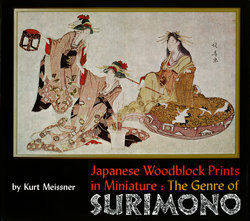Читать книгу Japanese Woodblock Prints in Miniature: The Genre of Surimon - Kurt Meissner - Страница 9
На сайте Литреса книга снята с продажи.
ОглавлениеIntroduction
Hundreds of excellent books already exist on the beauty, artists, and eminent importance of Japanese woodblock prints. But most of these books mention nothing about the masterpieces par excellence, the surimono. A few others have only little to report. Also in some of the large collections the surimono are completely missing or else only represented by a few sheets.
By no means should the Japanese "surimono" be translated by the English words "printed matter." "Printed matter" can have many meanings and is completely unsuitable to describe a work of art. Japanese woodblock prints, particularly surimono, are on no account mere reproductions of finished pictures. On the contrary, the artist created the exact design for the lines and colours of his pictures. His exclusive aim was to create a woodblock print; these are, therefore, absolute works of art—the work of an artist.
This work limits itself to surimono art. Sum means "to rub"; mono means "thing." The meaning of the term surimono (rubbed tiling) thus stems from the technique of printing. Surimono by no means equal the general ukiyo-e which were ordered and sold by art publishers. Rather, they were made in smaller numbers, in better quality, and for art-loving Maecenases who were experts and connoisseurs.
Surimono often had poems on them. Upon hearing a short poem recited in Japanese and by a Japanese, one may appreciate the elegant form and the softness of the language due to the multitude of vowels in Japanese. A good translator with poetic inclinations may be able to approximate these characteristics in translation; unfortunately, however, a simple art collector such as myself cannot. Therefore, for the translations offered in this work as samples of surimono poems, I must ask the reader's indulgence.
Living in Japan for 60 years and working as manager of a machinery import company, I was able to collect surimono from time to time. Many decades have passed since the first was purchased. As time went on, the collection and knowledge grew hand-in-hand and now there is enough material for a book specializing in surimono taken from my own collection (with the exception of Plates 12 and 32 which were borrowed from the Museum für Kunst und Gewerbe in Hamburg). My collection includes albums from the years 1787, 1798, 1810, and several other undated albums in addition. My feeling is that surimono, which the well-known French expert Louis Gonse called les plus séduisantes merveilles de l'art Japonais (the most attractive wonder of Japanese art), deserve a presentation of their own.
—Kurt Meissner
